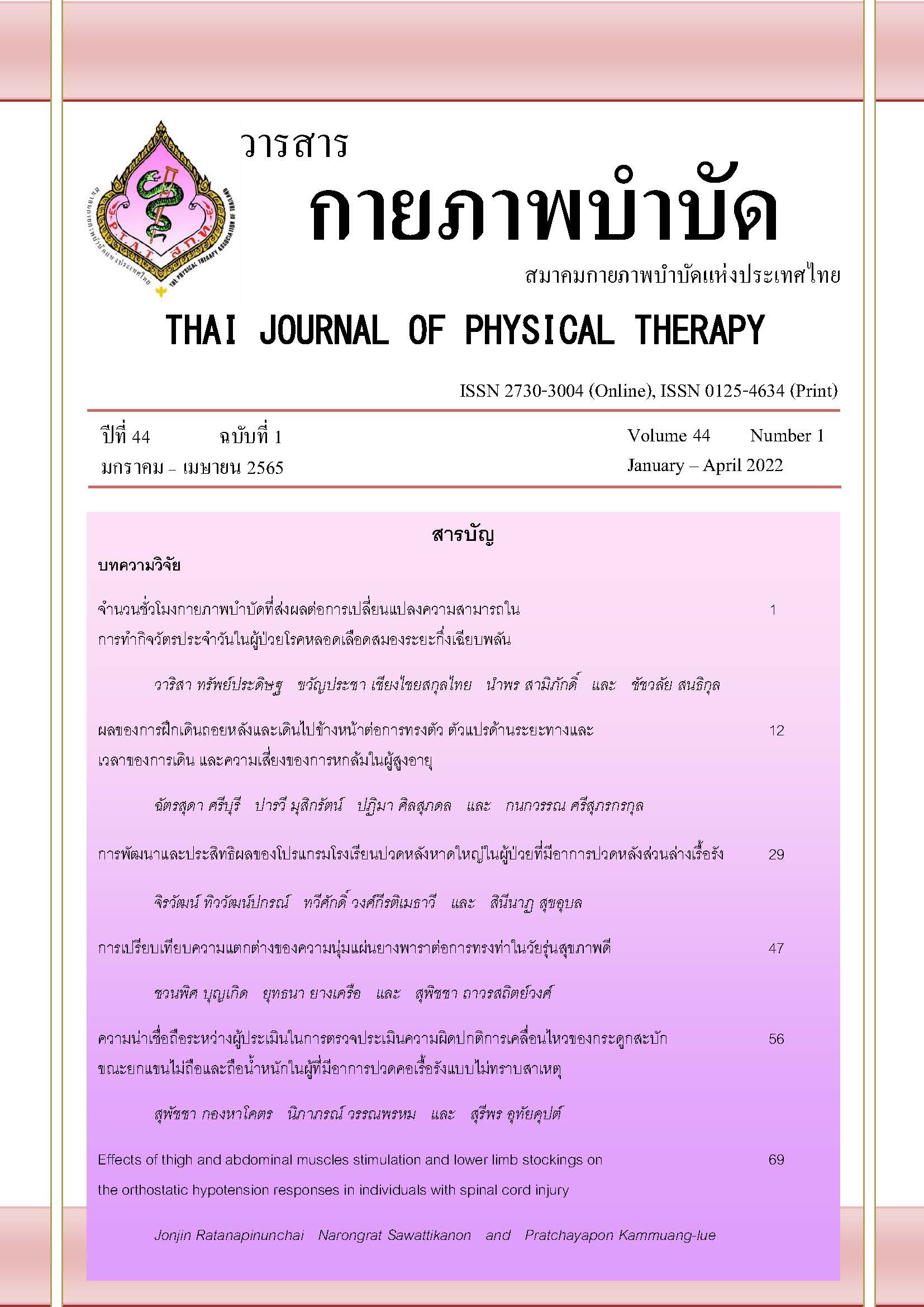จำนวนชั่วโมงกายภาพบำบัดที่ส่งผลต่อการเปลี่ยนแปลงความสามารถในการทำกิจวัตรประจำวันในผู้ป่วยโรคหลอดเลือดสมองระยะกึ่งเฉียบพลัน
Main Article Content
บทคัดย่อ
ที่มาและความสำคัญ: การรักษาทางกายภาพบำบัดอย่างเข้มข้นเป็นสิ่งสำคัญเพื่อให้ผู้ป่วยโรคหลอดเลือดสมองสามารถเคลื่อนไหวและกลับมาช่วยเหลือตนเองในการทำกิจวัตรประจำวัน อย่างไรก็ตาม ยังไม่มีการศึกษาใดศึกษาถึงจำนวนชั่วโมงการรักษาทางกายภาพบำบัดที่ส่งผลต่อการเปลี่ยนแปลงความสามารถในการทำกิจวัตรประจำวัน
วัตถุประสงค์: เพื่อศึกษาจำนวนชั่วโมงทางกายภาพบำบัดและปัจจัยที่ส่งผลต่อการเปลี่ยนแปลงความสามารถในการทำกิจวัตรประจำวันของผู้ป่วยโรคหลอดเลือดสมองระยะกึ่งเฉียบพลัน
วิธีการวิจัย: ผู้ป่วยโรคหลอดเลือดสมองระยะกึ่งเฉียบพลันจำนวน 283 คน ได้รับการเก็บข้อมูลและประเมินความสามารถในการทำกิจวัตรประจำวันและระดับความพิการด้วย Barthel index (BI) และ Modified Rankin scale (mRs) เมื่อแรกรับและที่ระยะเวลา 2 เดือนหลังจากเกิดโรคหลอดเลือดสมอง จากนั้นวิเคราะห์เปรียบเทียบโดยใช้สถิติ Paired t-test และ One-way ANOVA และปัจจัยที่ส่งผลต่อการเปลี่ยนแปลง BI วิเคราะห์โดยใช้สถิติ Logistic regression
ผลการวิจัย: ผลจากการศึกษาครั้งนี้พบว่าจำนวนชั่วโมงกายภาพบำบัด 10-15 ชั่วโมง มีความสัมพันธ์อย่างมีนัยสำคัญทางสถิติต่อการเปลี่ยนแปลงความสามารถในการทำกิจวัตรประจำวันของผู้ป่วยกลุ่มนี้
สรุปผล: การฟื้นฟูด้วยกายภาพบำบัดอย่างน้อย 10-15 ชั่วโมงในช่วง 2 เดือนแรกภายหลังการเกิดโรคหลอดเลือดสมองส่งผลให้เกิดการเปลี่ยนแปลงความสามารถในการทำกิจวัตรประจำวันของผู้ป่วยโรคหลอดเลือดสมองระยะกึ่งเฉียบพลัน
คำสำคัญ: จำนวนชั่วโมง กายภาพบำบัด กิจวัตรประจำวัน โรคหลอดเลือดสมอง กึ่งเฉียบพลัน
Article Details

อนุญาตภายใต้เงื่อนไข Creative Commons Attribution-NonCommercial-NoDerivatives 4.0 International License.
เอกสารอ้างอิง
Panmung N, Yolertlob A, Jeapo A. Campaign substance for world stroke day 2018. Bureau of Non Communicable Disease Department of disease control Ministry of Public Health 2018:1-4. (In Thai)
Bonita R, Beaglehole R. Recovery of motor function after stroke. Stroke 1988;19:1497-500.
Thai Physical Therapy Council. Situation of health workforce report. Human Resources Management Division Ministry of Public Health 2018. (In Thai)
Thai Physical Therapy Council. Physical Therapy Service Assessment Guide 2012. (In Thai)
Duncan PW, Goldstein LB, Matchar D, Divine GW, Feussner J. Measurement of motor recovery after stroke. Outcome assessment and sample size requirements. Stroke 1992;23:1084-9.
Winstein CJ, Stein J, Arena R, Bates B, Cherney LR, Cramer SC,et al. Guidelines for adult stroke rehabilitation and recovery: A guideline for healthcare professionals from the American Heart Association/American Stroke Association. Stroke 2016;47(6):e98-169.
Miller EL, Murray L, Richards L, Zorowitz RD, Bakas T, Clark P,et al. Comprehensive overview of nursing and interdisciplinary rehabilitation care of the stroke patient: a scientific statement from the American Heart Association. Stroke 2010;41(10):2402-48.
Theben J, Fearn J, Willems D, Sooley D, White J. Stroke rehabilitation intensity literature review. Ontario Stroke Network (OSN) Rehabilitation Intensity Working Group 2016:1-38.
Wit LD, Putman K, Schuback B, Komarek A, Angst F, Baert I,et al. Motor and functional recovery after stroke: a comparison of 4 European rehabilitation centers. Stroke 2007;38(7):2101-7.
McNaughton H, DeJong G, Smout RJ, Melvin JL, Brandstater M. A comparison of stroke rehabilitation practice and outcomes between New Zealand and United States facilities. Archives of Physical Medicine and Rehabilitation 2005;86(12 Suppl 2):S115-20.
Sonoda S, Saitoh E, Nagai S, Kawakita M, Kanada Y. Full-time integrated treatment program, a new system for stroke rehabilitation in Japan: comparison with conventional rehabilitation. American Journal of Physical Medicine and Rehabilitation 2004;83(2):88-93.
Wang H, Camicia M, Terdiman J, Mannava MK, Sidney S, Sandel ME. Daily treatment time and functional gains of stroke patients during inpatient rehabilitation. The Journal of Injury, Function and Rehabilitation 2013;5(2):122-8.
Subcommittee of service plan of intermediate care Guideline for intermediate care (service plan). Samutsakorn: Born to be publishing; 2019. (In Thai)
Institute of Neurology. The study for tertiary medical service and higher development in stroke. Nonthaburi: Institute of Neurology Ministry of Public Health; 2009. (In Thai)
Sehatzadeh S. Effect of increased intensity of physiotherapy on patient outcomes after stroke: an evidence-based analysis. Ontario Health Technology Assessment Series [Internet].2015; 15(6):1–42. Available from: http://www.hqontario.ca/evidence/publications-and-ohtac-recommendations/ontario-healthtechnology-assessment-series/increased-intensity-pt.
Billinger SA, Arena R, Bernhardt J, Janice J, Franklin BA, Johnson CM, et al. Physical activity and exercise recommendations for stroke survivors. Stroke 2014;45:2532-53.
Wade DT, Hewer RL, Wood VA. Functional abilities after stroke: measurement, natural history and prognosis Journal of Neurology, Neurosurgery, and Psychiatry 1987;50:177-82.
Duncan PW, Lai SM, Bode RK, Perera S, DeRosa J. Stroke Impact Scale-16: A brief assessment of physical function. Neurology 2003;60:291-6.
Rensink M, Schuurmans M, Lindeman E, Hafsteinsdottir T. Task-oriented training in rehabilitation after stroke: systematic review. Journal of Journal of Advanced Nursing 2009; 65:737-54.
Jorgensen HS, Nakayama H, Raaschou HO, Larsen JV, Stoier M, Olsen TS. Outcome and time course of recovery in stroke. part II: time course of recovery. The Copenhagen Stroke Study. Journal of Physical Medicine and Rehabilitation 1995;76:406-12.


